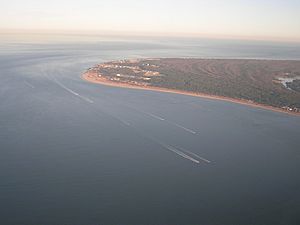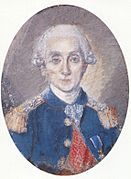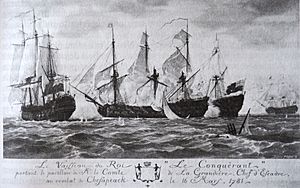Battle of Cape Henry facts for kids
Quick facts for kids Battle of Cape Henry |
|||||||
|---|---|---|---|---|---|---|---|
| Part of the American Revolutionary War | |||||||
 Aerial view of Cape Henry |
|||||||
|
|||||||
| Belligerents | |||||||
| Commanders and leaders | |||||||
| Strength | |||||||
| 8 ships of the line | 7 ships of the line 1 frigate |
||||||
| Casualties and losses | |||||||
| 30 killed 73 wounded |
72 killed 112 wounded |
||||||
The Battle of Cape Henry was a naval battle during the American Revolutionary War. It happened near the mouth of Chesapeake Bay on March 16, 1781. This fight was between a British fleet led by Vice Admiral Mariot Arbuthnot and a French fleet under Admiral Charles Sochet.
The French fleet, based in Newport, Rhode Island, sailed to the Chesapeake Bay. Their goal was to help the American army fight against the British army in Virginia. The British fleet followed them. The British ships were faster and reached the Chesapeake Bay first. The battle happened, and both sides had damage and injuries. No ships were lost, but the British managed to block the French from entering the bay. This meant the British won a strategic victory.
Contents
Why the Battle Happened
In December 1780, British General Sir Henry Clinton sent General Benedict Arnold to Virginia. Arnold, who had switched sides to the British, had about 1,700 soldiers. Their job was to raid areas and make Portsmouth stronger.
George Washington, the American general, sent the Marquis de Lafayette to stop Arnold. Washington also asked the French fleet in Newport, Rhode Island for help. The French admiral, Destouches, was careful. He knew the British fleet was nearby and a bit bigger.
A storm in February damaged some British ships. This made Destouches send three French ships south. When these ships reached the Chesapeake, the British ships supporting Arnold moved into a shallow river. The French ships could not follow them there.
The French ships returned to Newport. Their only success was capturing a British ship called Romulus. This small win, and encouragement from General Washington, made Destouches decide to send his whole fleet. On March 8, Destouches sailed with his entire fleet. He also carried 1,200 soldiers to help on land.
Vice-admiral of the White Mariot Arbuthnot, the British commander, knew the French were planning something. He learned about Destouches sailing on March 10. He immediately led his fleet to chase them. His ships were faster because they had copper on their hulls. They also had a good wind. Arbuthnot reached Cape Henry on March 16, just before the French.
- Commanders
-
Captain Sochet Des Touches
-
Admiral Mariot Arbuthnot
The Battle Begins
Both fleets had eight ships in their main battle lines. But the British had more powerful guns. The British ship London had 90 guns, making it the biggest ship. The French ship Duc de Bourgogne had 80 guns. The French fleet also had the Romulus, which was smaller with 44 guns.
At 6 AM on March 16, Arbuthnot saw the French fleet. They were about 40 nautical miles (74 km) east-northeast of Cape Henry. Arbuthnot turned his ships around. Destouches ordered his ships to form a line, heading west with the wind.
Between 8 and 9 AM, the wind started to change. It was hard to see clearly. Both fleets moved for several hours, trying to get the best position. The French had the advantage of the wind. Around 9:30 AM, Destouches ordered his ships to turn. As they turned, two French ships, Ardent and Éveillé, had problems with their sails. This slowed down the French line. The British saw this chance and moved closer.
Destouches ordered another turn, which brought his ships closer to the British. This also allowed Ardent and Éveillé to fix their sails and get back into line by 11 AM.
Fighting at Sea
By 1 PM, the wind was steady from the northeast. Arbuthnot was catching up to the back of the French line. Both fleets were heading east-southeast, sailing against the wind. Destouches then ordered his fleet to turn again. This put his ships in front of the British line.
By doing this, he gave up the advantage of the wind. But it also allowed his ships to open their lower gun decks in the rough seas. The British ships could not do this without water washing onto their lower decks.
Arbuthnot responded by ordering his fleet to turn. When the first ships in his line turned, they were fully exposed to the French fire. They were badly damaged. At 1:30 PM, the front ships of both fleets began fighting. The French ships fired heavily on the first three British ships. The British ships Robust, Europe, and Prudent were very hard to control because their sails and ropes were damaged. Arbuthnot kept his signal flying for his fleet to stay in line. So, the British fleet lined up behind their damaged ships.
As the French ship Conquérant got close to the British Robust, a cannonball hit its steering wheel. Four sailors steering the ship were killed, and the ship turned into the wind. The British ships Royal Oak (74 guns) and London (100 guns) came very close. But a lucky shot from Conquérant hit London's topsail yard, forcing it to stop. Conquérant stayed exposed for another 30 minutes. Then, it managed to make temporary repairs and rejoin the French line.
After about an hour of fighting, Destouches ordered his fleet to turn again. His ships fired on the damaged British ships one more time. Then, they pulled away to the east. The British ships were too damaged to chase them.
What Happened Next
The French had 72 killed and 112 wounded. The British had 30 killed and 73 wounded. Arbuthnot sailed into Chesapeake Bay. This stopped the French from achieving their goal. The French fleet returned to Newport to make repairs.
After the British sent 2,000 more soldiers to help Arnold, Arbuthnot went back to New York. He later left his job and went back to England.
The United States Congress thanked Destouches. General Washington was not happy that the mission failed. He wrote a letter that was a little critical of Destouches. This letter was found and printed in an English newspaper. This caused a disagreement between Washington and the French army commander, the Comte de Rochambeau.
Even though this French operation failed, later naval actions helped the Americans. The Comte de Grasse won the Battle of the Chesapeake in September 1781. This victory helped block the British army at Yorktown, Virginia, leading to their surrender.
Ships in the Battle
| Ship | Rate | Guns | Commander | Casualties | Notes | |||||
|---|---|---|---|---|---|---|---|---|---|---|
| Killed | Wounded | Total | ||||||||
| Robust | Third rate | 74 | Captain Phillips Cosby | 15 | 21 | 36 | ||||
| Europe | Third rate | 64 | Captain Smith Child | 8 | 19 | 27 | ||||
| Prudent | Third rate | 64 | Captain Thomas Burnet | 7 | 24 | 31 | ||||
| Royal Oak | Third rate | 74 | Captain William Swiney | 0 | 3 | 3 | Arbuthnot's flag | |||
| London | Second rate | 90 | Captain David Graves | 0 | 0 | 0 | Sir Thomas Graves' flag | |||
| Adamant | Fourth rate | 50 | Captain Gideon Johnstone | 0 | 0 | 0 | ||||
| Bedford | Third rate | 74 | Captain Edmund Affleck | 0 | 0 | 0 | ||||
| America | Third rate | 64 | Captain Samuel Thompson | 0 | 0 | 0 | ||||
| Casualty summary: 30 killed, 67 wounded, 97 total | ||||||||||
- Other British ships
- Guadelupe (frigate, 28 guns)
- Pearl (frigate, 32 guns)
- Iris (frigate, 32 guns)
- Medea (frigate, 28 guns)
| Ship | Type | Guns | Commander | Casualties | Notes | |||||
|---|---|---|---|---|---|---|---|---|---|---|
| Killed | Wounded | Total | ||||||||
| Conquérant | 74-gun | 74 | La Grandière | 43 | 50 | 93 | Lost her rudder and most of her rigging | |||
| Provence | 64-gun | 64 | Lombard | 1 | 7 | 8 | ||||
| Ardent | 64-gun | 64 | Marigny | 19 | 35 | 54 | Mainmast damaged | |||
| Neptune | 74-gun | 74 | Médine (WIA) | 4 | 2 | 6 | ||||
| Duc de Bourgogne | 80-gun | 80–84 | Durfort | 6 | 5 | 11 | ||||
| Jason | 64-gun | 64 | La Clocheterie | 5 | 1 | 6 | ||||
| Éveillé | 64-gun | 64 | Le Gardeur de Tilly | 1 | 3 | 4 | ||||
| Romulus | frigate | 44 | Le Saige de La Villèsbrunne | 2 | 1 | 3 | This was a two-deck frigate built by the British in 1777. | |||
| Casualty summary: 72 killed, 112 wounded, 184 total. | ||||||||||
- Other French ships
- Hermione (frigate, 36 guns)
- Gentille (frigate, 32 guns)
- Fantasque (14 guns)
- Surveillante (frigate, 32 guns)
Legacy
The Battle of Cape Henry is remembered in a song by American singer-songwriter Todd Snider. It's called "The Ballad of Cape Henry" and is on his 2008 album Peace Queer.
Cape Henry, Cape Henry, the battlefield's on fire
White water, white water, with those flames climbing higher
We fired our cannon at least two hours or more
Cape Henry, Cape Henry off of that old Virginia shore
There is a marker at the Cape Henry Memorial in Virginia for the Battle of the Chesapeake. However, there is no special recognition for this specific Battle of Cape Henry at that site.
See also
 In Spanish: Batalla del cabo Henry para niños
In Spanish: Batalla del cabo Henry para niños





